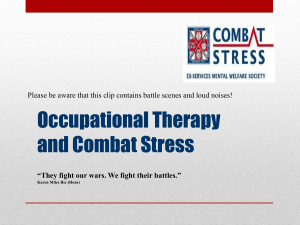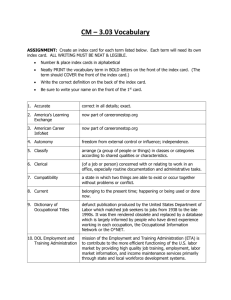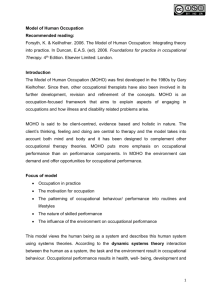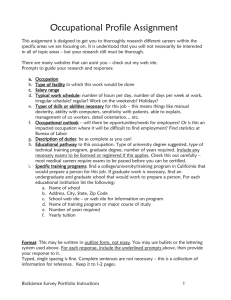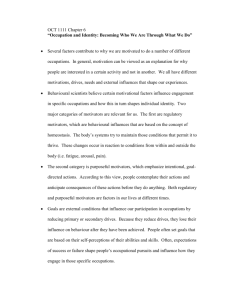Model of Human Occupation
advertisement
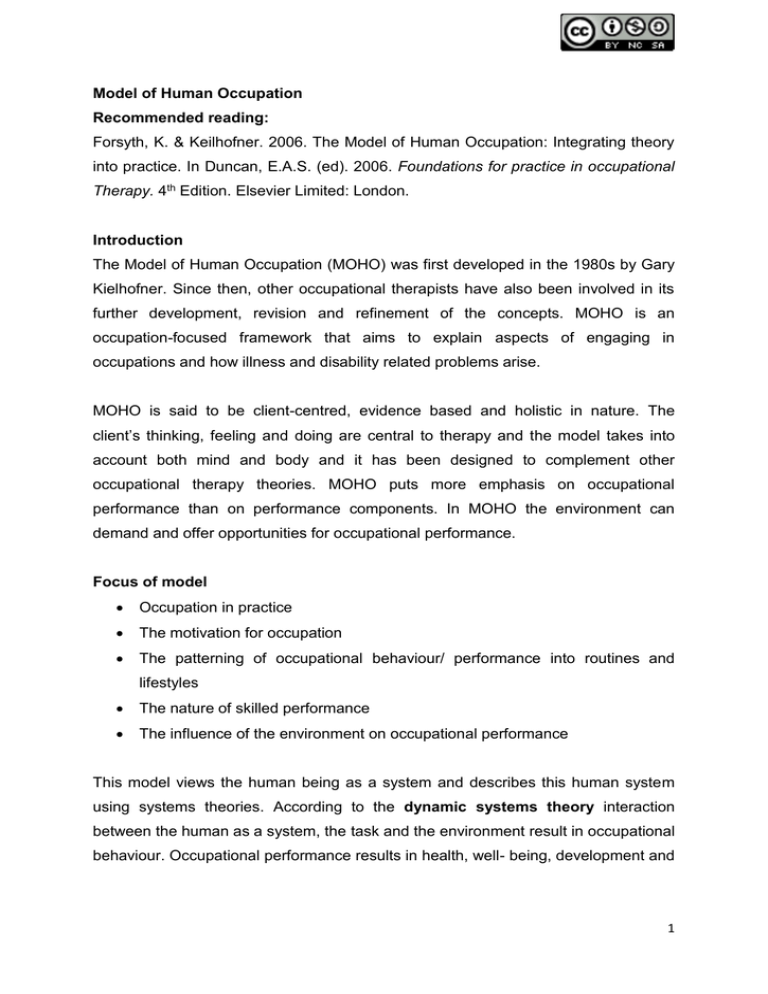
Model of Human Occupation Recommended reading: Forsyth, K. & Keilhofner. 2006. The Model of Human Occupation: Integrating theory into practice. In Duncan, E.A.S. (ed). 2006. Foundations for practice in occupational Therapy. 4th Edition. Elsevier Limited: London. Introduction The Model of Human Occupation (MOHO) was first developed in the 1980s by Gary Kielhofner. Since then, other occupational therapists have also been involved in its further development, revision and refinement of the concepts. MOHO is an occupation-focused framework that aims to explain aspects of engaging in occupations and how illness and disability related problems arise. MOHO is said to be client-centred, evidence based and holistic in nature. The client’s thinking, feeling and doing are central to therapy and the model takes into account both mind and body and it has been designed to complement other occupational therapy theories. MOHO puts more emphasis on occupational performance than on performance components. In MOHO the environment can demand and offer opportunities for occupational performance. Focus of model Occupation in practice The motivation for occupation The patterning of occupational behaviour/ performance into routines and lifestyles The nature of skilled performance The influence of the environment on occupational performance This model views the human being as a system and describes this human system using systems theories. According to the dynamic systems theory interaction between the human as a system, the task and the environment result in occupational behaviour. Occupational performance results in health, well- being, development and 1 change, therefore making it dynamic. The human system is constantly changing, unfolding and reorganising itself through engagement. Occupation is a process through which we organise our mind and body and through our minds and body we organise our occupation: we become what we dooccupational identity. Fundamental Concepts of the model: 1. Human occupation is complex 2. A person is made up of components 3. The environment influences performance 4. Occupational performance 1. Basic assumptions to understanding the complexity of human occupation: The human is a dynamic system. Elements of the system work together to produce behaviour. Behaviour is dynamic and context dependent. Behaviour changes continuously to meet the demands and opportunities afforded by the context. Occupations are the essence of self organisation, therefore through everyday doing, people shape that they are. Occupation is a result of motivation, patterns, performance capacity factors and environmental influences. Doing during the therapy process enables people to reshape their occupational abilities and identities, therefore becoming more adaptive. 2. The components of the person Occupational participation is chosen, patterned and performed through three interrelated components of the person, namely: a) Volition- values, interests and personal causation b) Habituation- habits and roles 2 c) Performance capacity- the mental and physical attributes and lived experiences The components: Volition Volition constitutes self knowledge or common sense that is gained through experience and dispositions. Dispositions refer to the cognitive/ emotional orientation towards occupations, such as enjoyment, value, feelings of competence and others. It enables humans to anticipate, choose, experience and interpret occupational behaviour and it results in thoughts, feelings and decisions about engaging in occupations. Therefore, volition could simply be articulated as the motivation process of choosing what to do. Personal narratives could be used to elicit information on volition. Volition encompasses values, interests and personal causation. Values are about the beliefs, commitments and significance that people attach to occupations and they are likely to engage in those that they deem as important. Values create a strong disposition to perform according to standards set by context. There are consequences attached to not acting according to values. Interests relates to perceptions, feelings and emotions associated with pleasure and satisfaction. Therefore, the person would choose to engage in an occupation that he/she finds satisfying and enjoyable. Interests are generated from positive experiences or can be based on the anticipation of enjoyment attached to engagement. Personal causation refers to the perceived present and potential effectiveness to act on the world with regards to mental and physical capabilities. This knowledge about own capabilities is dynamic and continuously unfolds to the individual. This process is internally controlled and informed. Volition is continuously changing as new experiences can reinforce, challenge and elaborate on existing dispositions and self knowledge. In summary our motivation to choose to engage in occupations is influenced by our values, beliefs about ability and meaning attached to activity and capabilities. 3 Habituation Actions are organised into patterns of behaviour that become routines. Integration into our temporal, social, physical and cultural environments is through these patterns of behaviour. Habituation comprises of habits and roles, which are often resistant to change. Habits are automatic learned ways in which we respond and perform in familiar situations. For habits to develop actions have to be repeated to be able to establish a pattern and there has to be consistency in the environment. Habits operate at a subconscious level and they influence a wide range of behaviour patterns. Roles MOHO states that we behave and act in learned ways that are associated with a social identity or status. Our actions are embedded in our social roles or are performed in full or partial fulfilment of a social role. Roles influence our interactions with others, the style, manner and content as well as the role related tasks that form daily routine. Habits regulate routine actions and behaviour within a role. The interwoven nature of habits and roles is evident in daily life and in turn, routine behaviour is organized. The onset of disability or illness can disturb established habits and therefore would require relearning or developing new habits. This would require sustained practice in order to change habituation. Performance Capacity This is the ability to perform an act, based on the status of one’s mental and physical capabilities, as well as lived experiences. Capabilities include the musculoskeletal, cardiopulmonary, neurological and other physiological systems that enable action. The capabilities are objectively assessed and the experiences are subjective and they shape performance. An area of interest in MOHO is on the lived experiences of people with disabilities and how they perform. 4 3. Environment The environment is made up the physical, social, cultural, economic and political aspects that impact on how occupations are motivated, organised and performed. It provides the opportunities and resources for engagement and also presses for certain behaviour or presents constraints to engagement. Within the environment there are objects, spaces, occupational tasks or form, culture and political and economic influences that affect occupational performance. Different environments will have different effects on each person, because humans are unique beings. According to MOHO, the contribution of the three components and environment to occupation is heterarchical in nature. This means that aspects of the components and the environment all contribute to a dynamic whole. 4. Occupational Performance This constitutes the actual doing which can be demonstrated at different levels, namely: skill, occupational performance, identity, participation, competence and adaptation. It results from a heterarchical contribution from the components of the person, namely; volition, habituation and performance capacity and the environment. Occupational performance is dynamic in nature, because it is influenced and shaped by external environment that is continuously changing. It is also spontaneous and must be understood within the context of emerging action and conditions. Function- Dysfunction continuum Through behaviour we create identity, concepts and motor abilities, therefore when we engage in new behaviour we reshape ourselves, hence our occupational identities. Consistent practice enables one to progress to the level of mastery, therefore occupational competence. Continuously reshaping and refining both occupational identity and occupational competence results in becoming more occupationally adaptive. Through participation in therapeutic occupations we become adaptive and healthier. 5 Implications for practice MOHO has a range of resources that can be used in practice. When using the framework, occupational therapists engage people in occupations that restore, reorganise or maintain their motivation, patterning and performance capacity, therefore their occupational lives. MOHO Resources: Assessment tools Intervention protocols Programmes Case examples Refer to these resources to gain an understanding of how to put the concepts of MOHO into practice. References: Kielhofner, G. 2008. Model of Human Occupation Theory and Application. 4 th Ed. Baltimore: Lippincott Williams & Wilkins. Forsyth, K. & Keilhofner. 2006. The Model of Human Occupation: Integrating theory into practice. In Duncan, E.A.S. (ed). 2006. Foundations for practice in occupational Therapy. 4th Edition. Elsevier Limited: London. MOHO Clearing House. MOHO related resources. [Online]. Available: http://www.moho.uic.edu/mohorelatedrsrcs.html#OtherMOHOproducts Conceptual Frameworks by Matumo Ramafikeng, Health Sciences UCT, 2010 Licensed under a Creative Commons Attribution-Noncommercial-Share Alike 2.5 South Africa License. 6
